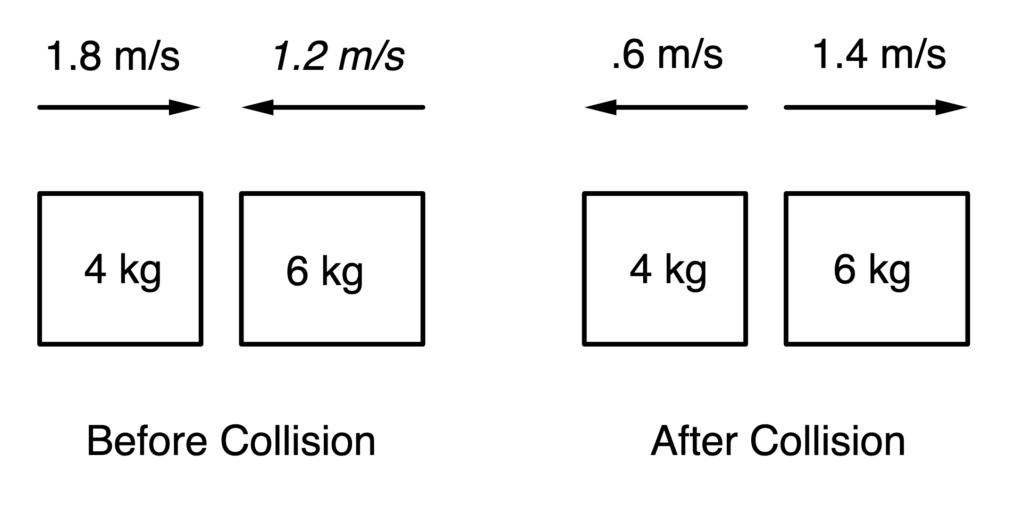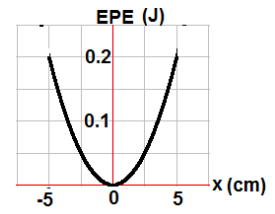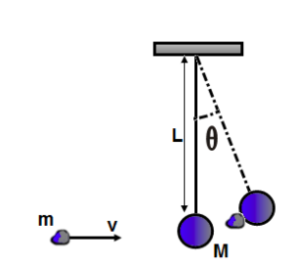0 attempts
0% avg
UBQ Credits
# (a) Direction of the resultant force acting on the marble at point C
The resultant force acting on the marble at point C is directed towards the center of the loop. This force is mainly comprised of the gravitational force pulling downwards and the normal force exerted by the track which also points towards the center of the loop during the circular motion.
# (b) Names of all the forces acting on the marble at point C
| Force | Description |
|---|---|
| Gravitational Force | The force due to gravity acting downwards towards the center of the earth. |
| Normal Force | The force exerted by the surface of the loop on the marble directed radially inward, toward the center of the loop. |
# (c) Deduce the speed of the marble at point C. The working below uses two seperate conservation of energy equations. However, it can also be done in a single equation such that the postential energy at A transfroms into the potential energy at C and the kinetic energy at C. This is written as [katex] mgh_A = mgh_C + \frac{1}{2}mv^2 [/katex].
| Step | Derivation/Formula | Reasoning |
|---|---|---|
| 1 | [katex] h_A = 0.8 \, \text{m} [/katex] | Initial height from which the marble is released. |
| 2 | [katex] v_A = 0 \, \text{m/s} [/katex] | Initial velocity (marble is released from rest). |
| 3 | [katex] v_B = \sqrt{2gh_A} [/katex] | Re-arrange and solve for velocity at the bottom of the incline, using conservation of mechanical energy, where [katex] mgh_A = \frac{1}{2}m{v^2}_B [/katex]. |
| 4 | [katex] v_B = \sqrt{2 \times 9.8 \times 0.8} [/katex] | Calculating [katex] v_B [/katex]. |
| 5 | [katex] v_B \approx 3.97 \, \text{m/s} [/katex] | Approximate calculation of velocity at point B. |
| 6 | [katex] h_C = 0.35 \, \text{m} [/katex] | The maximum height attained by the marble is at point C (top of loop). |
| 7 | [katex] v_C^2 = v_B^2 – 2gh_C [/katex] | Using conservation of mechanical energy between points B and C. |
| 8 | [katex] v_C^2 = 3.97^2 – 2 \times 9.8 \times 0.35 [/katex] | Calculating [katex] v_C [/katex] from [katex] v_B [/katex] and change in gravitational potential energy. |
| 9 | [katex] v_C \approx 3.0 \, \text{m/s} [/katex] | Approximate calculation of velocity at point C. |
# (d) Effect if the release height of the marble were to double
| Step | Derivation/Formula | Reasoning |
|---|---|---|
| 1 | [katex] mgh_A = mgh_C + \frac{1}{2}mv^2 [/katex] | The conservation of energy between points A and C, as used in part B. |
| 2 | [katex] gh_A = gh_C + \frac{1}{2}v^2 [/katex] | Simplified formula. |
| 3 | [katex] g\Delta h = \frac{1}{2}v^2 [/katex] | Further simplifying by replacing [katex] gh_A \,- \,gh_c [/katex] with [katex] g\Delta h [/katex] which is simply the change in height. |
| 4 | [katex] \frac{\Delta h}{v^2} = \frac{1}{2g} [/katex] | Place [katex] \Delta h [/katex] and [katex] v^2 [/katex] on the same side of the equation to clearly see they are directly proportional. |
| 5 | Conclusion. | Since [katex] \Delta h [/katex] and [katex] v^2 [/katex], if you doulbe height the velocity would increase proportionally by [katex] \boxed{\sqrt{2}} [/katex] for a final speed of [katex] 3 \times \sqrt{2} \approx 4.24 \, \text{m/s}[/katex]. |
Just ask: "Help me solve this problem."
A 0.035 kg bullet moving horizontally at 350 m/s embeds itself into an initially stationary 0.55 kg block. Air resistance is negligible.

From the figure above, determine the which characteristic fits this collision best.
A car is safely negotiating an unbanked circular turn at a speed of 21 m/s. The road is dry, and the maximum static frictional force acts on the tires. Suddenly a wet patch in the road decreases the maximum static frictional force to one-third its dry road value. If the car is to continue safely around the curve, to what speed must the driver slow the car?

A 0.4 kg object is attached to a horizontal spring undergoes SHM with the total energy of 0.2 J. The potential energy as a function of position presented by the graph.

A 20 g piece of clay moving at a speed of 50 m/s strikes a 500 g pendulum bob at rest. The length of a string is 0.8 m. After the collision the clay-bob system starts to oscillate as a simple pendulum.
By continuing you (1) agree to our Terms of Sale and Terms of Use and (2) consent to sharing your IP and browser information used by this site’s security protocols as outlined in our Privacy Policy.
| Kinematics | Forces |
|---|---|
| \(\Delta x = v_i t + \frac{1}{2} at^2\) | \(F = ma\) |
| \(v = v_i + at\) | \(F_g = \frac{G m_1 m_2}{r^2}\) |
| \(v^2 = v_i^2 + 2a \Delta x\) | \(f = \mu N\) |
| \(\Delta x = \frac{v_i + v}{2} t\) | \(F_s =-kx\) |
| \(v^2 = v_f^2 \,-\, 2a \Delta x\) |
| Circular Motion | Energy |
|---|---|
| \(F_c = \frac{mv^2}{r}\) | \(KE = \frac{1}{2} mv^2\) |
| \(a_c = \frac{v^2}{r}\) | \(PE = mgh\) |
| \(T = 2\pi \sqrt{\frac{r}{g}}\) | \(KE_i + PE_i = KE_f + PE_f\) |
| \(W = Fd \cos\theta\) |
| Momentum | Torque and Rotations |
|---|---|
| \(p = mv\) | \(\tau = r \cdot F \cdot \sin(\theta)\) |
| \(J = \Delta p\) | \(I = \sum mr^2\) |
| \(p_i = p_f\) | \(L = I \cdot \omega\) |
| Simple Harmonic Motion | Fluids |
|---|---|
| \(F = -kx\) | \(P = \frac{F}{A}\) |
| \(T = 2\pi \sqrt{\frac{l}{g}}\) | \(P_{\text{total}} = P_{\text{atm}} + \rho gh\) |
| \(T = 2\pi \sqrt{\frac{m}{k}}\) | \(Q = Av\) |
| \(x(t) = A \cos(\omega t + \phi)\) | \(F_b = \rho V g\) |
| \(a = -\omega^2 x\) | \(A_1v_1 = A_2v_2\) |
| Constant | Description |
|---|---|
| [katex]g[/katex] | Acceleration due to gravity, typically [katex]9.8 , \text{m/s}^2[/katex] on Earth’s surface |
| [katex]G[/katex] | Universal Gravitational Constant, [katex]6.674 \times 10^{-11} , \text{N} \cdot \text{m}^2/\text{kg}^2[/katex] |
| [katex]\mu_k[/katex] and [katex]\mu_s[/katex] | Coefficients of kinetic ([katex]\mu_k[/katex]) and static ([katex]\mu_s[/katex]) friction, dimensionless. Static friction ([katex]\mu_s[/katex]) is usually greater than kinetic friction ([katex]\mu_k[/katex]) as it resists the start of motion. |
| [katex]k[/katex] | Spring constant, in [katex]\text{N/m}[/katex] |
| [katex] M_E = 5.972 \times 10^{24} , \text{kg} [/katex] | Mass of the Earth |
| [katex] M_M = 7.348 \times 10^{22} , \text{kg} [/katex] | Mass of the Moon |
| [katex] M_M = 1.989 \times 10^{30} , \text{kg} [/katex] | Mass of the Sun |
| Variable | SI Unit |
|---|---|
| [katex]s[/katex] (Displacement) | [katex]\text{meters (m)}[/katex] |
| [katex]v[/katex] (Velocity) | [katex]\text{meters per second (m/s)}[/katex] |
| [katex]a[/katex] (Acceleration) | [katex]\text{meters per second squared (m/s}^2\text{)}[/katex] |
| [katex]t[/katex] (Time) | [katex]\text{seconds (s)}[/katex] |
| [katex]m[/katex] (Mass) | [katex]\text{kilograms (kg)}[/katex] |
| Variable | Derived SI Unit |
|---|---|
| [katex]F[/katex] (Force) | [katex]\text{newtons (N)}[/katex] |
| [katex]E[/katex], [katex]PE[/katex], [katex]KE[/katex] (Energy, Potential Energy, Kinetic Energy) | [katex]\text{joules (J)}[/katex] |
| [katex]P[/katex] (Power) | [katex]\text{watts (W)}[/katex] |
| [katex]p[/katex] (Momentum) | [katex]\text{kilogram meters per second (kgm/s)}[/katex] |
| [katex]\omega[/katex] (Angular Velocity) | [katex]\text{radians per second (rad/s)}[/katex] |
| [katex]\tau[/katex] (Torque) | [katex]\text{newton meters (Nm)}[/katex] |
| [katex]I[/katex] (Moment of Inertia) | [katex]\text{kilogram meter squared (kgm}^2\text{)}[/katex] |
| [katex]f[/katex] (Frequency) | [katex]\text{hertz (Hz)}[/katex] |
General Metric Conversion Chart
Example of using unit analysis: Convert 5 kilometers to millimeters.
Start with the given measurement: [katex]\text{5 km}[/katex]
Use the conversion factors for kilometers to meters and meters to millimeters: [katex]\text{5 km} \times \frac{10^3 \, \text{m}}{1 \, \text{km}} \times \frac{10^3 \, \text{mm}}{1 \, \text{m}}[/katex]
Perform the multiplication: [katex]\text{5 km} \times \frac{10^3 \, \text{m}}{1 \, \text{km}} \times \frac{10^3 \, \text{mm}}{1 \, \text{m}} = 5 \times 10^3 \times 10^3 \, \text{mm}[/katex]
Simplify to get the final answer: [katex]\boxed{5 \times 10^6 \, \text{mm}}[/katex]
Prefix | Symbol | Power of Ten | Equivalent |
|---|---|---|---|
Pico- | p | [katex]10^{-12}[/katex] | 0.000000000001 |
Nano- | n | [katex]10^{-9}[/katex] | 0.000000001 |
Micro- | µ | [katex]10^{-6}[/katex] | 0.000001 |
Milli- | m | [katex]10^{-3}[/katex] | 0.001 |
Centi- | c | [katex]10^{-2}[/katex] | 0.01 |
Deci- | d | [katex]10^{-1}[/katex] | 0.1 |
(Base unit) | – | [katex]10^{0}[/katex] | 1 |
Deca- or Deka- | da | [katex]10^{1}[/katex] | 10 |
Hecto- | h | [katex]10^{2}[/katex] | 100 |
Kilo- | k | [katex]10^{3}[/katex] | 1,000 |
Mega- | M | [katex]10^{6}[/katex] | 1,000,000 |
Giga- | G | [katex]10^{9}[/katex] | 1,000,000,000 |
Tera- | T | [katex]10^{12}[/katex] | 1,000,000,000,000 |
The most advanced version of Phy. 50% off, for early supporters. Prices increase soon.
per month
Billed Monthly. Cancel Anytime.
Trial –> Phy Pro
A quick explanation
Credits are used to grade your FRQs and GQs. Pro users get unlimited credits.
Submitting counts as 1 attempt.
Viewing answers or explanations count as a failed attempts.
Phy gives partial credit if needed
MCQs and GQs are are 1 point each. FRQs will state points for each part.
Phy customizes problem explanations based on what you struggle with. Just hit the explanation button to see.
Understand you mistakes quicker.

Phy automatically provides feedback so you can improve your responses.
10 Free Credits To Get You Started

By continuing you agree to nerd-notes.com Terms of Service, Privacy Policy, and our usage of user data.